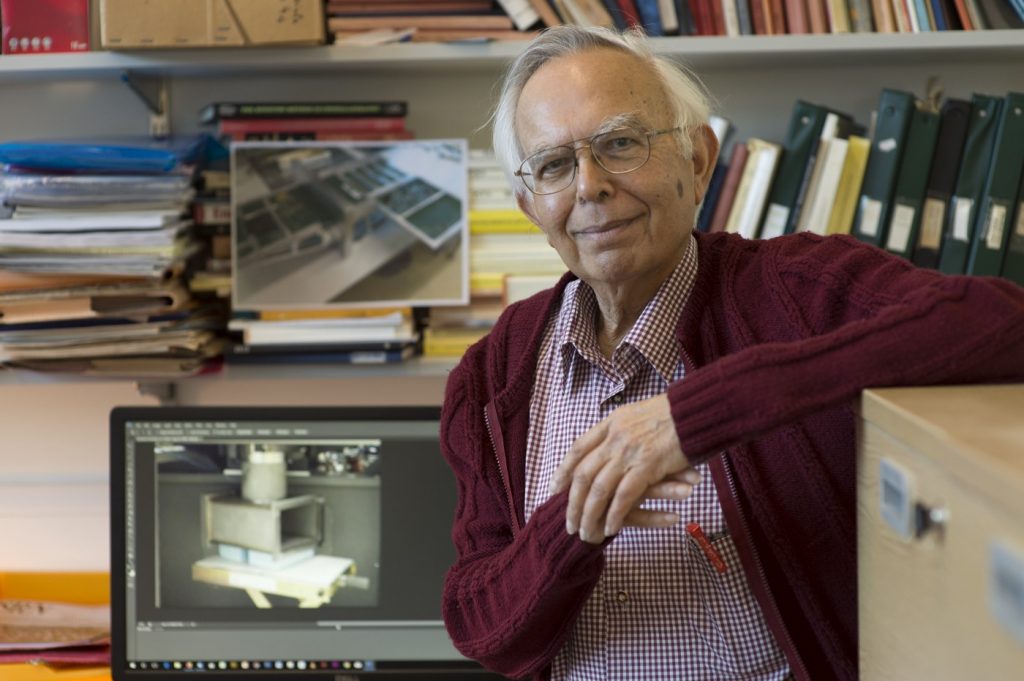‘Being part of Clare Hall was, and still is, an altogether enriching experience’
Dr Wasi Faruqi received an MBE last year, for work completed over many years at the MRC Laboratory of Molecular Biology. Here Wasi shares a little about his career, and what he most values about being a Life Member of Clare Hall.

I was introduced to Clare Hall in 1986 by Murray Stewart, a colleague from the MRC-LMB who was a Fellow of the College.
At that time an eminent Structural Biologist, Sir Michael Stoker was the President and Dr Leslie Barnett, another colleague from the LMB, was Senior Tutor at Clare Hall. Although it helped to know a few people it was soon clear from the friendly atmosphere that one did not need long to meet and get to know new people. In this respect the seating arrangements at meals were a great help, as they encouraged mixing.
I joined the MRC Laboratory of Molecular Biology located on the New Addenbrooke’s Hospital site on Hills Road in 1969.
My previous degree was not from Cambridge so I was not familiar with the college system and for many years after joining the MRC-LMB I remained unaware of the advantages of college life. Very recently, as a result of my receiving the Queen’s Award (MBE), the MRC-LMB’s archivist composed a brief summary of my work at the laboratory, which I am linking to here to avoid repetition.
A brief word about some of my earlier interests at the MRC-LMB:
Previously, X-ray and Electron Microscopy images and diffraction patterns were mainly recorded on film, which needed processing and scanning before any results could be obtained. My initial work was done with Hugh Huxley, a pioneer in the field of Muscle Physiology and Mechanism. Since the experiments were recording transient phenomena, they needed to be done with higher intensity X-ray beams than were available in the laboratory. Fortunately, a new method of generating higher intensities became available from electron synchrotrons (used by Particle Physicists for conducting particle collision experiments). An unwanted by-product of synchrotrons (at least for the Particle Physicist) is parasitic synchrotron radiation, which includes X-rays at useful wavelengths. We spent a good deal of time in designing new cameras, which would be transported and installed at Daresbury Laboratory near Manchester and subsequently at DESY in Hamburg.
The work cited in the MBE record is for developing detectors for electron microscopy

Following my spell with X-ray instrumentation I have spent the most recent, approximately thirty years working on electronic detectors for electron microscopy
— appropriately named electron cryo-microscopy or cryo-EM for short, as the specimen is kept at Liquid Nitrogen temperature. The work cited in the MBE record is for developing detectors for electron microscopy, which have been instrumental in obtaining much higher resolution macromolecular structures than were possible with film, or indeed with previous electronic detectors in use until about 2013. There were many other parallel developments, which led to the ‘Resolution Revolution’ in cryo-EM and detectors were just one part of this work. Realisation of high resolution means being able to ‘visualise’ individual atoms within a biomolecule or indeed biomolecular complexes, which is now being employed in drug design amongst other benefits. The achievement of such fantastic resolutions was already predicted on theoretical grounds by Richard Henderson in 1995 when being able ‘see’ atoms in biological molecules was just a pipe dream. The realisation of that prediction about twenty years later led to a flurry of excitement, with many groups joining in the race to achieve ever higher resolution and a Nobel Prize in Chemistry for Richard Henderson, Jacques Dubochet and Joachim Franck in 2017.
You could be sitting between a postgraduate student and a retired Professor

The aspects I find most attractive about Clare Hall are numerous:
the multi-disciplinary atmosphere — a great deal of mixing between the sciences and the arts; many interesting and relaxed conversations over the convivial meals with historians, philosophers and even scientists from other Faculties; no rigid barriers between ages, so you could be sitting between a postgraduate student and a retired Professor. These are just some of the things that come to mind. Of course, there were also some wonderful musical recitals that were put on by the College and some excellent talks. Personally, I also enjoyed the art displayed in the corridors. Being part of Clare Hall was, and still is, an altogether enriching experience.
Because of the diversity and the many nationalities present at these social gatherings, it was a great place for obtaining first-hand information on countries I was interested in or indeed about to visit.
I remember chatting with a peer one lunchtime as I was considering a scientific visit to several centres in the USSR and I picked up some valuable tips on how to conduct myself in scientific/social circles in that country. I remember some very interesting discussions, for example, on the background to the Civil conflict in Sri Lanka with a recently arrived scholar from that country with a close understanding of the issues which gave rise to the conflict in the first place. Clare Hall also offered excellent possibilities for networking with colleagues in a social environment. One of my friends from Physics, for example, came and discussed aspects of the design of an electronic camera, with enhanced speed compared to what had been available previously.
Visitors from abroad were often curious about the Cambridge college system and entertaining them at Clare Hall gave them a flavour of college life.
It was also possible to meet eminent writers, amongst others, who came to Cambridge to do research. One such writer was Anita Desai. It was such a privilege to meet someone like her and it could only really happen in a place like Clare Hall.
The MRC Laboratory of Molecular Biology (LMB) is a research institute dedicated to the understanding of important biological processes at the levels of atoms, molecules, cells and organisms. Learn more at https://www2.mrc-lmb.cam.ac.uk/